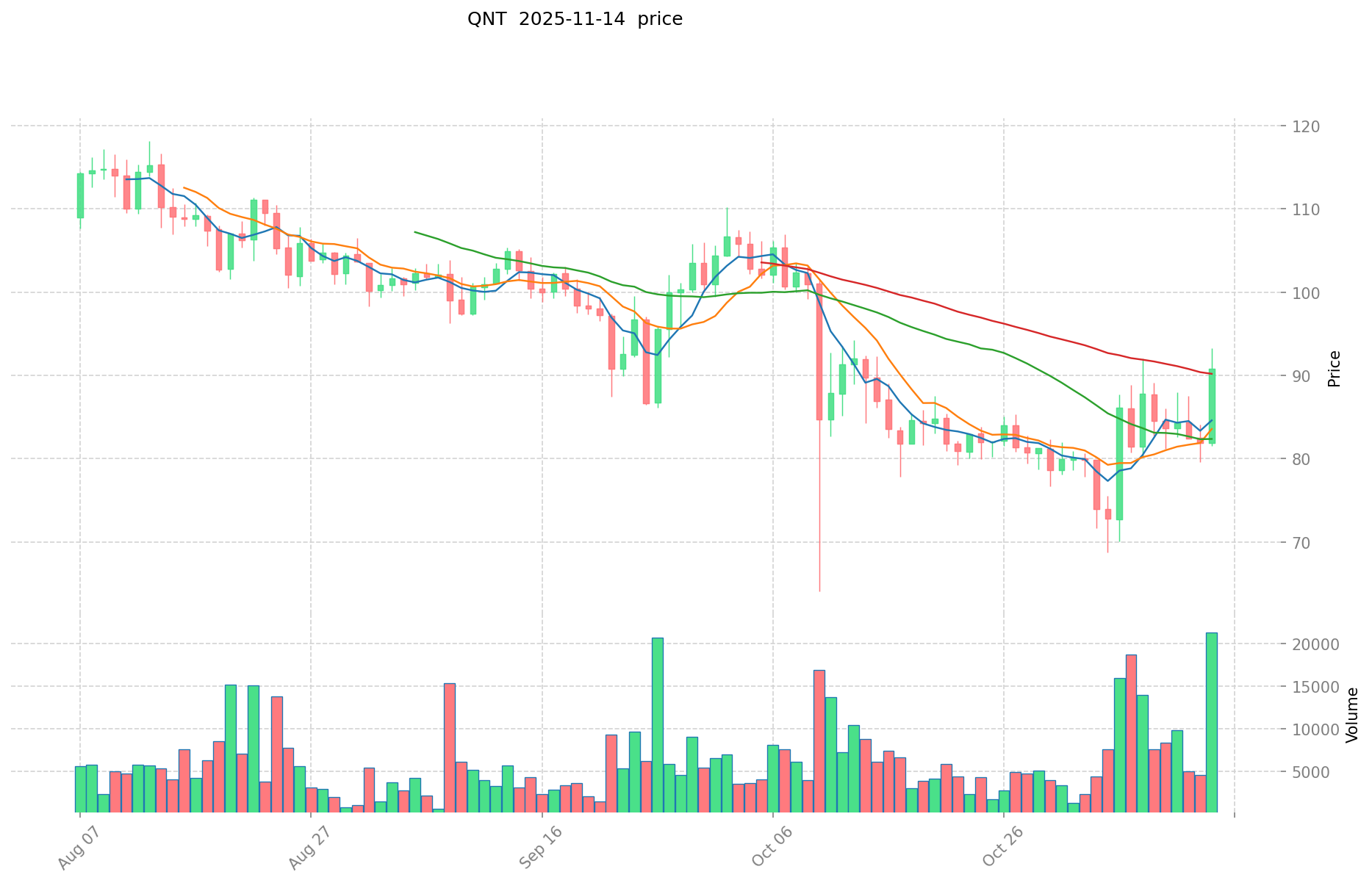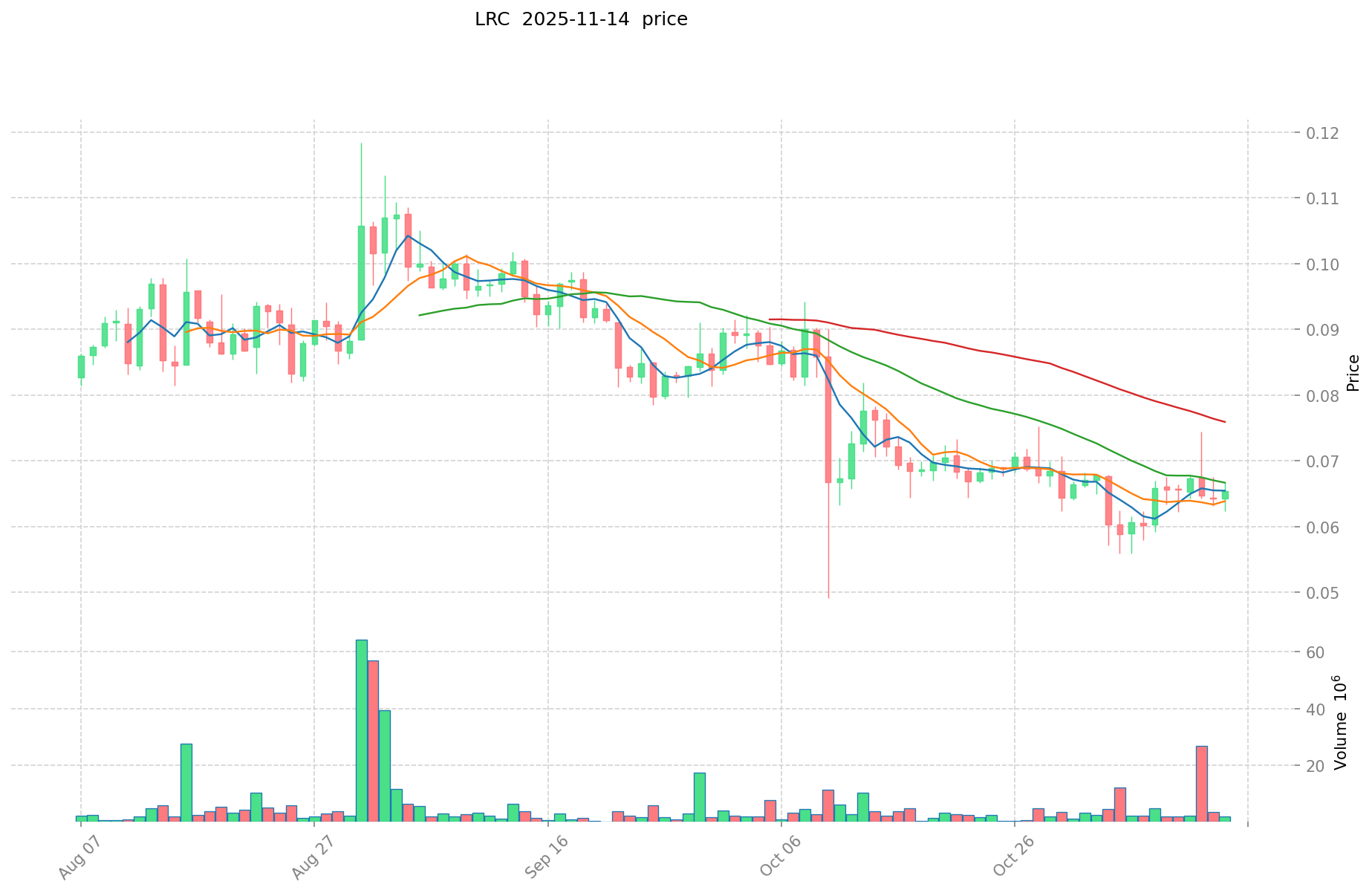QNT vs LRC: Comparing Two Promising Cryptocurrencies in the Digital Asset Space
Introduction: QNT vs LRC Investment Comparison
In the cryptocurrency market, the comparison between Quant (QNT) and Loopring (LRC) has been an unavoidable topic for investors. The two not only differ significantly in market cap ranking, application scenarios, and price performance, but also represent different positioning in the crypto asset space.
Quant (QNT): Since its launch in 2018, it has gained market recognition for its focus on enabling trusted digital interaction for businesses and governments.
Loopring (LRC): Introduced in 2017, it has been known for its decentralized token exchange protocol, aiming to provide zero-risk token exchange models.
This article will comprehensively analyze the investment value comparison between QNT and LRC, focusing on historical price trends, supply mechanisms, institutional adoption, technological ecosystems, and future predictions, attempting to answer the question most important to investors:
"Which is the better buy right now?"
I. Price History Comparison and Current Market Status
QNT (Coin A) and LRC (Coin B) Historical Price Trends
- 2021: QNT reached its all-time high of $427.42 on September 11, 2021, likely due to increased adoption of its blockchain interoperability solutions.
- 2021: LRC hit its all-time high of $3.75 on November 10, 2021, possibly influenced by the growing interest in layer-2 scaling solutions for Ethereum.
- Comparative analysis: Since their respective peaks in 2021, QNT has shown more resilience, currently trading at $85.91, while LRC has experienced a more significant decline, now priced at $0.06231.
Current Market Situation (2025-11-15)
- QNT current price: $85.91
- LRC current price: $0.06231
- 24-hour trading volume: QNT $1,834,131.75 vs LRC $114,843.77
- Market Sentiment Index (Fear & Greed Index): 16 (Extreme Fear)
Click to view real-time prices:
- Check QNT current price Market Price
- Check LRC current price Market Price


II. Core Factors Influencing QNT vs LRC Investment Value
Supply Mechanisms Comparison (Tokenomics)
- QNT: Fixed maximum supply of 14,612,493 tokens with a deflationary model where tokens are burned with network usage
- LRC: Total supply of approximately 1.37 billion tokens with deflationary mechanisms including token burns from protocol fees
- 📌 Historical Pattern: QNT's limited supply model has historically created stronger scarcity value, while LRC's larger supply with burn mechanisms provides gradual deflationary pressure.
Institutional Adoption and Market Applications
- Institutional Holdings: QNT has gained more institutional interest with adoption by major financial networks, while LRC has less institutional backing but growing interest from DeFi participants
- Enterprise Adoption: QNT has stronger enterprise adoption through Overledger OS and partnerships with payment networks; LRC focuses on DEX infrastructure for trading platforms
- Regulatory Attitudes: QNT generally receives more favorable regulatory treatment due to its enterprise focus, while LRC faces more scrutiny as part of the DeFi ecosystem
Technology Development and Ecosystem Building
- QNT Technology Upgrades: Overledger Network connecting multiple blockchains to legacy systems; focus on interoperability for financial institutions
- LRC Technology Development: Layer 2 scaling solutions on Ethereum, zkRollup technology, and DEX protocol improvements
- Ecosystem Comparison: QNT emphasizes enterprise applications and interoperability across financial networks; LRC focuses on DeFi trading infrastructure, NFT marketplace support, and payment solutions within the Ethereum ecosystem
Macroeconomic and Market Cycles
- Inflation Performance: QNT has demonstrated stronger performance during inflationary periods due to its fixed supply and enterprise adoption
- Macroeconomic Monetary Policy: Both tokens are affected by interest rate changes, with QNT showing more resilience during tightening cycles
- Geopolitical Factors: QNT benefits more from cross-border transaction demand due to its positioning in international financial infrastructure
III. Price Predictions for 2025-2030: QNT vs LRC
Short-term Predictions (2025)
- QNT: Conservative $59.44 - $86.14 | Optimistic $86.14 - $94.75
- LRC: Conservative $0.042 - $0.062 | Optimistic $0.062 - $0.092
Mid-term Predictions (2027)
- QNT may enter a growth phase, with expected prices ranging from $71.15 to $136.10
- LRC may enter a growth phase, with expected prices ranging from $0.080 to $0.135
- Key drivers: Institutional capital inflow, ETFs, ecosystem development
Long-term Predictions (2030)
- QNT: Base scenario $136.35 - $143.52 | Optimistic scenario $143.52 - $152.13
- LRC: Base scenario $0.072 - $0.132 | Optimistic scenario $0.132 - $0.150
Disclaimer: The information provided is for informational purposes only and should not be considered as financial advice. Cryptocurrency markets are highly volatile and unpredictable. Always conduct your own research before making any investment decisions.
QNT:
| 年份 | 预测最高价 | 预测平均价格 | 预测最低价 | 涨跌幅 |
|---|---|---|---|---|
| 2025 | 94.754 | 86.14 | 59.4366 | 0 |
| 2026 | 115.77216 | 90.447 | 87.73359 | 5 |
| 2027 | 136.1046456 | 103.10958 | 71.1456102 | 20 |
| 2028 | 126.783539568 | 119.6071128 | 96.881761368 | 39 |
| 2029 | 163.84978382472 | 123.195326184 | 82.54086854328 | 43 |
| 2030 | 152.1339083046216 | 143.52255500436 | 136.346427254142 | 67 |
LRC:
| 年份 | 预测最高价 | 预测平均价格 | 预测最低价 | 涨跌幅 |
|---|---|---|---|---|
| 2025 | 0.091982 | 0.06215 | 0.042262 | 0 |
| 2026 | 0.1078924 | 0.077066 | 0.0462396 | 23 |
| 2027 | 0.135019632 | 0.0924792 | 0.079532112 | 48 |
| 2028 | 0.11829939264 | 0.113749416 | 0.0682496496 | 82 |
| 2029 | 0.1473509934864 | 0.11602440432 | 0.0904990353696 | 86 |
| 2030 | 0.150123976749648 | 0.1316876989032 | 0.07242823439676 | 111 |
IV. Investment Strategy Comparison: QNT vs LRC
Long-term vs Short-term Investment Strategies
- QNT: Suitable for investors focused on enterprise blockchain solutions and interoperability
- LRC: Suitable for investors interested in DeFi and Layer 2 scaling solutions
Risk Management and Asset Allocation
- Conservative investors: QNT: 60% vs LRC: 40%
- Aggressive investors: QNT: 70% vs LRC: 30%
- Hedging tools: Stablecoin allocation, options, cross-currency portfolios
V. Potential Risk Comparison
Market Risk
- QNT: Volatility due to limited supply and institutional adoption cycles
- LRC: Higher volatility influenced by overall DeFi market sentiment
Technical Risk
- QNT: Scalability, network stability
- LRC: Smart contract vulnerabilities, Ethereum network congestion
Regulatory Risk
- Global regulatory policies may impact QNT less due to its enterprise focus, while LRC could face more scrutiny as part of the DeFi ecosystem
VI. Conclusion: Which Is the Better Buy?
📌 Investment Value Summary:
- QNT advantages: Strong institutional adoption, limited supply, focus on interoperability
- LRC advantages: Growing DeFi ecosystem, Layer 2 scaling solutions, potential for rapid growth
✅ Investment Advice:
- New investors: Consider a higher allocation to QNT due to its relative stability and institutional backing
- Experienced investors: Balanced portfolio with both QNT and LRC, adjusting based on risk tolerance
- Institutional investors: Focus on QNT for its enterprise solutions and regulatory-friendly positioning
⚠️ Risk Warning: Cryptocurrency markets are highly volatile. This article does not constitute investment advice. None
VII. FAQ
Q1: What are the main differences between QNT and LRC in terms of their focus and technology? A: QNT focuses on enabling trusted digital interaction for businesses and governments through its Overledger Network, which connects multiple blockchains to legacy systems. LRC, on the other hand, is known for its decentralized token exchange protocol and Layer 2 scaling solutions on Ethereum, including zkRollup technology.
Q2: How do the supply mechanisms of QNT and LRC compare? A: QNT has a fixed maximum supply of 14,612,493 tokens with a deflationary model where tokens are burned with network usage. LRC has a total supply of approximately 1.37 billion tokens with deflationary mechanisms including token burns from protocol fees.
Q3: Which token has shown more price resilience since their all-time highs in 2021? A: QNT has shown more resilience since its all-time high in 2021. As of 2025-11-15, QNT is trading at $85.91, while LRC has experienced a more significant decline and is priced at $0.06231.
Q4: How does institutional adoption differ between QNT and LRC? A: QNT has gained more institutional interest and adoption, particularly from major financial networks and enterprises. LRC has less institutional backing but growing interest from DeFi participants.
Q5: What are the long-term price predictions for QNT and LRC by 2030? A: By 2030, QNT is predicted to reach $136.35 - $152.13 in an optimistic scenario, while LRC is expected to reach $0.072 - $0.150 in an optimistic scenario.
Q6: How do the investment strategies for QNT and LRC differ? A: QNT is generally considered suitable for investors focused on enterprise blockchain solutions and interoperability, while LRC is more suited for investors interested in DeFi and Layer 2 scaling solutions. Conservative investors might consider allocating 60% to QNT and 40% to LRC, while aggressive investors might opt for 70% QNT and 30% LRC.
Q7: What are the main risks associated with investing in QNT and LRC? A: For QNT, risks include volatility due to limited supply and institutional adoption cycles, as well as technical risks related to scalability and network stability. LRC faces higher volatility influenced by overall DeFi market sentiment, smart contract vulnerabilities, and potential regulatory scrutiny as part of the DeFi ecosystem.
Share
Content